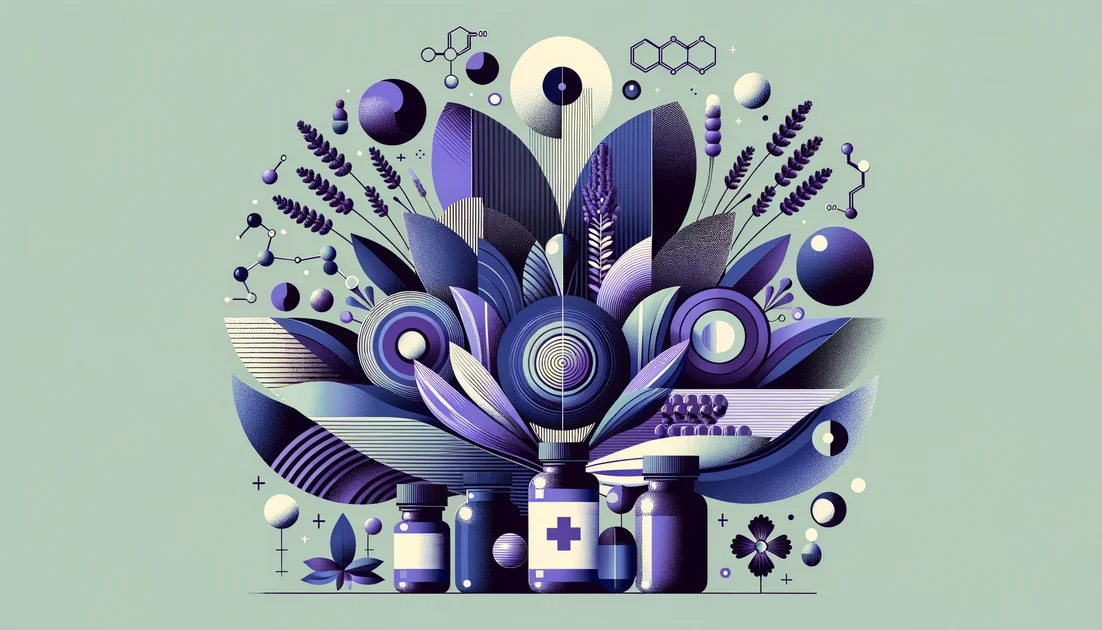
From Monk's Yellow to Metabolic Clues: What Berberine Really Does (and Doesn't) Do
In 868 CE, the world's oldest printed book—the Diamond Sutra—was dyed a luminous yellow. Chemists later confirmed the color came from berberine, an intensely bitter plant alkaloid that clings to paper fibers and wool with stubborn devotion. Today, that same bitterness is drawing attention for a different reason: it seems to whisper to our metabolism through the gut. How did a monk's dye become a modern health obsession?[1][2]
- Evidence
- Promising
- Immediate Effect
- No → 8-12 weeks
- Wears Off
- Often within ~2 months after stopping, based on washout data
A bitter thread through history
Berberine lives in the roots and bark of barberry, goldenseal, and Chinese goldthread (Huanglian). For centuries, East Asian doctors reached for Huanglian to cool raging gut infections, fevers, and "damp-heat"—a poetic diagnosis that often meant diarrhea or inflamed skin. Ayurveda's daruharidra told a similar story across the Himalayas. Modern hospitals still recognize the same plant family; Memorial Sloan Kettering's monograph lists these traditional uses and names berberine as a key active component.[3]
The modern puzzle: hardly absorbed, yet widely felt
Here's the paradox that fascinates researchers: swallowed berberine barely gets into the blood, yet people's labs sometimes improve. Early on, this looked like a contradiction. Then a new character entered the plot—the microbiome. Reviews now suggest berberine acts like a foreman at the gut's loading dock, reshaping bacteria, bile acids, and signaling molecules that in nudge liver and muscle toward better sugar and fat handling.[4][5] Part of the story involves the gut's "taste" sensors. Berberine's bitterness can flip on receptors in intestinal hormone cells, prompting small surges of GLP-1—the meal-time signal that helps the pancreas release insulin and steadies post-meal glucose. Think of it as tapping the body's own dimmer switch rather than installing a new light fixture.[6] This is worlds apart from prescription GLP-1 drugs, which flood that system with a potent hormone mimic.
What trials show—tempered optimism
When researchers pooled randomized trials, berberine supplementation was associated with modest improvements in blood sugar: fasting glucose down roughly 0.7–0.8 mmol/L and HbA1c by about 0.6 percentage points on average. That's meaningful for some, but not a miracle—and trial quality varies.[7][8] On blood lipids, placebo-controlled trials found small average drops in LDL (~18 mg/dL), triglycerides, and apoB, with a curious twist: HDL rose more in women than men in subgroup analyses.[9] One trial offers a rare "on–off–on" window. Participants took 500 mg twice daily for 3 months, stopped for 2 months, then restarted. Cholesterol improved on berberine, worsened during washout, and improved again after reintroduction—suggesting the effect depends on continued use rather than a permanent reset.[10] So, how should a health-conscious reader interpret this? The weight of evidence suggests modest improvements in glucose and lipids over 8–12 weeks, particularly in insulin-resistant states, with gastrointestinal side effects the most common complaint. That's promising—but not decisive enough to replace standard care.
Two expert reality checks
"No, it's not [nature's Ozempic].. and we should be skeptical when social media dispenses so-called health advice." — Toni Golen, MD, Harvard Health Publishing.[11]
"As for it being nature's Ozempic, there's no evidence to suggest that is true." — Caroline Apovian, MD, Brigham and Women's Hospital.[12]
These quotes capture an important boundary: while berberine may gently steady metabolism, it does not replicate prescription GLP-1 medicines for weight loss. Media comparisons distract from what berberine actually does best—small metabolic nudges via the gut-liver axis.
The cautionary tales we learn from
Case reports keep clinicians humble. An athletic man in his 40s collapsed with low blood sugar after taking berberine for performance; he recovered, but the episode underscored that even non-diabetics can overshoot when a supplement tugs on glucose control.[15] Another thread is pharmacology: berberine can slow the liver's breakdown of certain drugs, notably raising levels of cyclosporine in transplant recipients in clinical studies—an interaction strong enough to alter dosing.[13] And because berberine can displace bilirubin from its carrier, botanicals rich in it should be avoided in jaundiced newborns; major cancer centers flag this explicitly.[3][14]
Why bitterness matters more than milligrams
Remember the dye that held fast to the Sutra's pages? That same stickiness shows up in the intestine: berberine tends to stay local. There, it reworks bile-acid traffic—the body's detergent-like molecules that digest fats and signal to the liver—and nudges bacterial guilds that ferment fiber and cross-talk with our immune and endocrine systems.[5] The net effect is like a choir warming up: no single voice is blasting, but together they shift the room's tone. Because absorption is so poor, scientists are experimenting with different "vehicles." Dihydroberberine, a reduced form, shows higher human plasma levels in a small crossover trial, hinting at better delivery; newer micellar formulations aim to escort berberine through the gut's watery barrier and have early safety data in healthy adults.[16][17] These are prototypes, not prescriptions—but they outline where the field is going.
If you're considering berberine
What seems to work in trials looks like this:
Dose and time: 900–1500 mg per day, often split with meals, for at least 8–12 weeks to judge effect. Expect gradual changes rather than an immediate shift.[9][7]
Who may notice benefits: people with insulin resistance or type 2 diabetes looking for small HbA1c reductions; those with borderline-high LDL or triglycerides; some with PCOS and metabolic features, as part of a broader plan.[7][9]
What to watch: stomach upset, constipation, or loose stools are common. If you take drugs cleared by CYP3A4 (e.g., cyclosporine), or you're prone to low blood sugar, discuss risks and monitoring with your clinician.[13][15][11]
Quality counts: supplements aren't pre-approved like drugs in the U.S.; choose third-party tested products and consistent dosing, and loop in your care team so lab changes are interpreted in context.[11]
The honest bottom line
As a molecule, berberine is less a sledgehammer than a set of levers—the bitter signal that turns on small, coordinated adjustments in the gut-liver conversation. Meta-analyses show it can modestly reduce glucose and atherogenic lipids; stories from clinics remind us to respect interactions and individual variability. That's a far cry from a miracle—but it's not nothing.
What's next
Two avenues stand out. First, delivery innovation: forms like dihydroberberine or micelles may allow lower doses with fewer gut complaints—if larger, longer trials confirm real-world benefits.[16][17] Second, precision nutrition: sex-specific lipid effects and microbiome-linked responses point to a future where we match the right person to the right plant compound, rather than one-size-fits-all.[9][5] And that yellow dye? It's a reminder that the old pharmacopeia often worked through the senses—bitter taste on the tongue, a color that won't wash out. In a world chasing shortcuts, berberine's lesson is subtler: sometimes the path to metabolic change runs through the gut's quiet negotiations, not the bloodstream's fireworks.[1][6][5]
Key takeaways
- •Berberine's paradox: it's poorly absorbed yet can shift glucose and lipid labs, likely through gut-mediated actions rather than high blood levels.
- •Expect modest effects: small average drops in fasting glucose, HbA1c, LDL, triglycerides, and apoB; HDL gains may be larger in women.
- •Dosing pattern used in trials: 900–1500 mg per day, split with meals (e.g., 500 mg twice daily) for at least 8–12 weeks before reassessing labs.
- •Practical use case: adults with insulin resistance, type 2 diabetes, borderline-high LDL/TGs, or PCOS features seeking incremental support alongside lifestyle and prescribed care.
- •Cautions: GI upset is common; monitor glucose if on anti-diabetic meds, avoid with cyclosporine due to marked level increases, and avoid berberine-rich botanicals in jaundiced neonates.
- •Mindset: it's a nudge, not a shortcut—benefits often depend on continued intake and may reverse within weeks after stopping.
You might also like
Explore more of our evidence-led investigations, comparisons, and guides across every article style.

XYMOGEN
XYMOGEN's practitioner paradox: testing-forward and tool-rich—now selling direct to consumers

Magnesium glycinate (magnesium bisglycinate) vs Magnesium citrate
If you want daily magnesium without looser stools, choose glycinate. If you need constipation relief or don't mind a mild laxative effect, choose citrate. Evidence for sleep/stress benefits is modest regardless of form [3][4][7][9].


Turkesterone (phytoecdysteroid from Ajuga turkestanica)
You hear the pitch at the gym: "It's like steroids—but natural." The bottle says turkesterone, a plant steroid from a Central Asian herb. But when scientists followed the clues, the trail didn't lead where marketers promised.


Tocotrienols
The stealthier cousins of vitamin E—built with springy tails that move differently in cell membranes and behave differently in your body.


